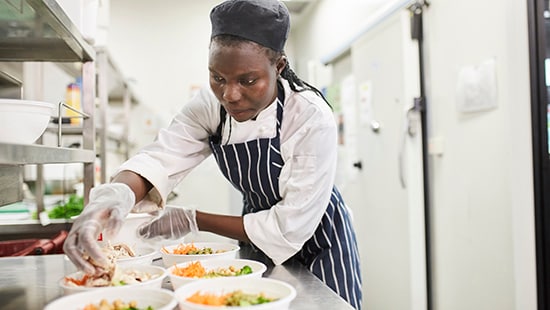Don’t Let Labor Shortages Short-Circuit Your Food Safety Program
5 Smart Strategies to Streamline Food Safety

We’ve all read, heard, seen and felt the strain of labor pressures on restaurant operations nationwide. But here’s a serious impact that’s not getting big headlines: the food safety risks among overstretched and less-experienced workers.
It’s The Little Things That Fall By The Wayside
A May 2022 survey showed 4 in 5 restaurants are still struggling to meet staffing needs — compounded by the fact that most restaurants say business is now back to, or above, pre-pandemic levels. This means employees are stretched thin, carrying more responsibilities as they pick up the slack. Front-of-house staff is juggling more guests while trying to still deliver great service, while skeleton-crew kitchen teams are just trying to get food out fast enough to keep up with demand.
Of course, everyone has the best intentions with food safety. But food safety is all in the details, and it’s the little things that get overlooked or pushed aside first when the pressure is on and resources are limited.
For Less Experienced Workers, Food Safety Isn’t Second Nature
Veterans of the restaurant business have had food safety practices drilled into them for years, with hand hygiene and preventing cross-contamination becoming second nature. But as restaurants bring in less-experienced workers to fill staffing gaps, operators can’t count on these practices being second nature. Some workers are coming in with zero foodservice experience — and have no existing knowledge of food safety best practices, while others are making a leap from front-of-house to back-of-house — or vice versa.
The food safety knowledge gap is one half of the challenge. The other is compliance — working food safety best practices into hurried workflows. These protocols may seem like little things on their own, but less-experienced workers are already learning completely new roles, mastering new skills and trying to build efficient habits.
5 Strategies to Strengthen Your Food Safety Program
How are restaurants dealing with these challenges? Here are five smart strategies that restaurant leaders — from the unit level all the way up to corporate leadership — can use to bolster their core food safety program:
- Get back to the basics: Invest in food safety training and ongoing education
There has been a recent wake-up call on the mistake of assuming familiarity with food safety basics. For example, the “Golden Rule” of food safety is, “Wash hands and surfaces often.” But in early 2020, we all realized that most don’t follow proper hand-washing protocols, and many don’t understand the important differences between cleaning, sanitizing and disinfecting surfaces. The lesson for restaurants: There’s no such thing as “too basic” when it comes to food safety training. Even more experienced workers benefit from refreshers and going back through the basics can help correct bad habits that often form in the pursuit of efficiency.- Building a better food safety training program
Our Ecolab Food Safety 101 toolkit provides a comprehensive guide for restaurant managers and leaders. It has everything they need to build — or re-boot — a modern food safety program. - Offering on-demand digital training
With workers of different experience levels, food safety training can’t be one-size-fits-all. Restaurants can leverage programs such as Ecolab’s On-Demand Digital Training available 24/7 on any device, to help employees consistently achieve cleaning outcomes that support food safety initiatives.
- Building a better food safety training program
- Make it easy: Simplify food safety protocols with innovative products
When employees are juggling more, there’s greater pressure to find shortcuts that may present food safety risks. The goal should be to make it as easy as possible to follow food safety protocols and best practices — to make the right way the easy way.- Making hand hygiene second nature
One of the best examples of making food safety easy is hand hygiene. Ecolab has helped thousands of restaurants to take a more strategic approach, delivering hand care solutions that combine chemistry, technology and training to make it simple, fast and instinctive for workers to wash hands frequently and consistently. - A faster way to reliable surface cleaning
Cutting corners is not acceptable, but you can give your workers shortcuts. Modern chemistry innovation offers a number of multi-purpose products that help make it faster and easier for employees to follow best practices. For example, Ecolab Sink & Surface Cleaner Sanitizer is a no-rinse, 2-in-1 food contact surface cleaner sanitizer that helps streamline and accelerate food safety protocols.
- Making hand hygiene second nature
- Go digital: Use digital tech to monitor and validate compliance
Even the best restaurant manager can’t possibly see everything. And unlike other cleaning tasks, food safety issues can sometimes be hard to see until it’s too late. Some of the savviest managers and restaurant leaders utilize digital tools for powerful visibility across their food safety programs.- Digital platforms provide critical visibility and insight
Select restaurants are digitizing their food safety programs with purpose-built platforms. These digital platforms replace paper checklists and endless computer spreadsheets, putting all food safety compliance data in one place. Leading platforms even provide analytics tools that automatically identify gaps and emerging issues, so you can take action before an incident. - IoT and connected sensors put eyes and ears everywhere
Just about every device in the front and back of the house is getting “smart,” using integrated sensors that automatically collect and transmit key information, such as temperature monitoring, for monitoring and compliance reporting purposes. This automation frees workers from repetitive data collection and compliance documentation requirements. Foodservice Intelligence powered by ECOLAB3D™ provides critical visibility and insight into restaurant operations. Digitally enabled solutions are designed to collect and analyze data into actionable alerts to identify gaps and emerging issues so you can act before an incident.
- Digital platforms provide critical visibility and insight
- Bring in the experts: leverage food safety training and compliance monitoring programs
The cruel irony of the ongoing labor shortages is that managers, who are wearing more hats than ever, are overstretched filling gaps and putting out fires. Most don’t have free time to be leading additional food safety training or prioritizing more frequent food safety monitoring. So, it’s no surprise that more restaurants are leaning on trusted partners to help them tackle these food safety challenges.
At Ecolab, foodservice customers can utilize our EcoSure Food Safety Program. We’re providing onsite food safety assessments, led by our microbiologists and food safety experts, to help them understand their risks and gaps — and actively helping them close those gaps by providing digital training and onsite coaching to build better food safety habits.
- Lead from the top: Build a food safety culture
Leaders know that details matter. And food safety is a game of details. As mentioned earlier, the pressure to delight guests and meet higher volume can overshadow food safety — unless food safety is a priority shouted from the top.
But savvy foodservice leaders are recognizing that guest experience, brand reputation and business success are all critically dependent on a foundation of food safety. So, they’re working to foster a culture that reinforces food safety as a top priority.
Ecolab is helping foodservice leaders take a programmatic approach to building a science-based food safety culture. We’re helping restaurants construct science-backed protocols that make it easier and faster to clean effectively. We’re giving restaurants digital tools and expertise to focus their attention where it matters most. And we’re creating cues of clean to demonstrate and celebrate a culture of food safety that makes employees proud and guests confident.



